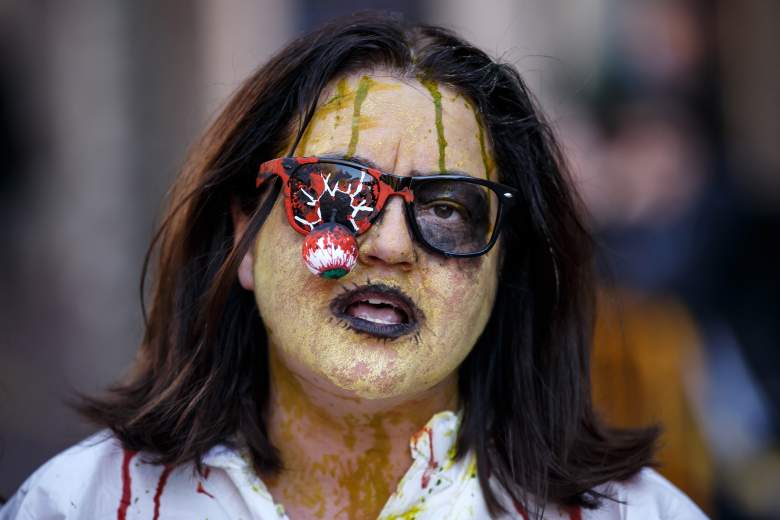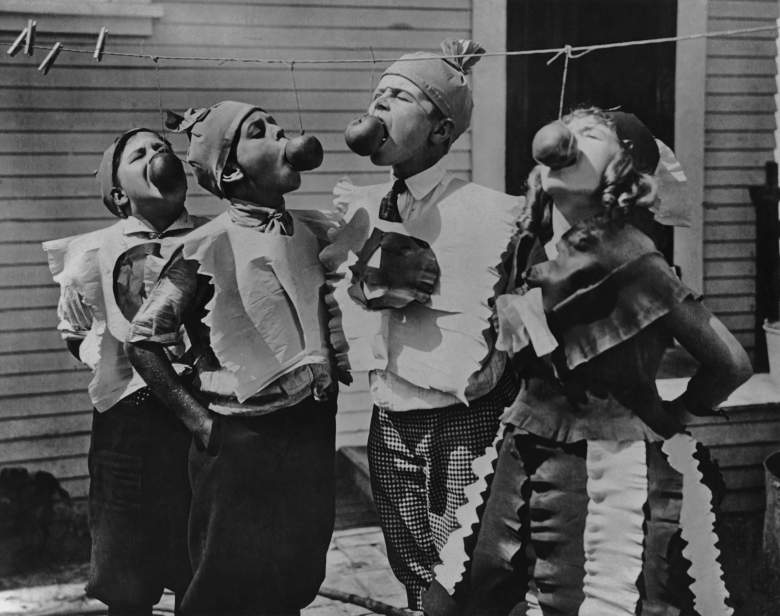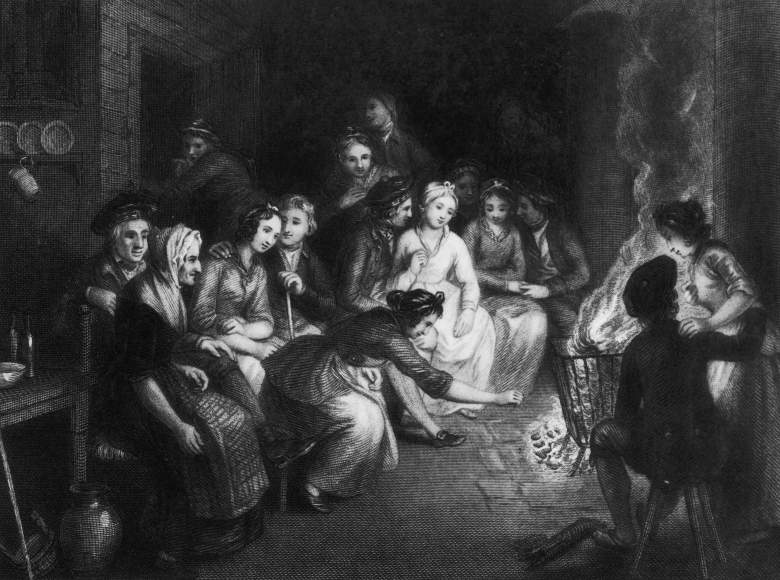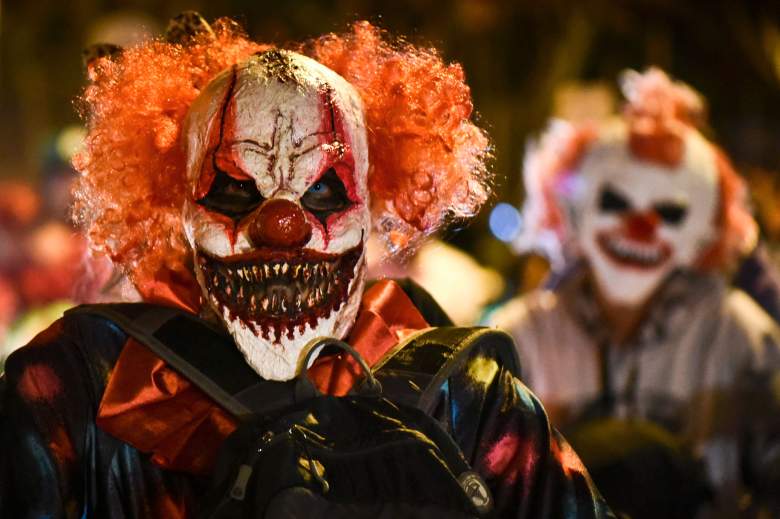
A person dressed as a zombie during an event in Spain. (Getty)
Halloween predates our favorite TV specials, horror films, candy or traditions.
The holiday has its roots in the 8th Century, as a feast before All Hallows’ Day, which celebrated all saints. Over the centuries that followed “All Hallows’ Eve” transformed into “Halloween” or “Hallowe’en.” The traditions we celebrate today, like dressing up in costumes, are Celtic in origin and the ‘standardized’ way of celebrating the holiday worldwide only really began to develop during the Victorian era.
Halloween is always on October 31. This year, it falls on a Monday. Here’s a look at the holiday’s roots.
1. Halloween Started as a Feast Before All Saints’ Day

(Getty)
While today’s view of Halloween includes ghosts and ghouls, the original incarnation of the holiday was meant to celebrate saints, not sinners. All Saints’ Day was previously on May 13. As the Encyclopedia Britannica notes, Pope Gregory III, who was Pope from 731 to 741, moved the holiday to November 1. As was customary at the time, this meant that there would be “All Hallows’ Eve” feasts the night before the holiday.
In 1000, the Church declared November 2 as All Souls’ Day to honor the dead. By this time, Christianity was spreading through the Celtic nations (Ireland, Scotland, Wales, Cornwall, Brittany and the Isle of Mann) and it’s thought that the Church created this holiday to create a Church-sanctioned holiday near the Celtic day of the dead festival known as Samhain.
2. Our Favorite Halloween Traditions Come From the Celtic Holiday Samhain

An illustration of Halloween in Scotland in the 1780s. (Getty)
Samhain was the Celtic “day of the dead” festival, held on November 1. As History.com points out, the holiday (pronounced sow-in) dates back over 2,000 years ago and was really the new year for the Celts. For them, it was the beginning of a new season and the time to start a harvest. They also associated it with death and new beginnings. They started celebrating the holiday the night before, as they believed ghosts were returning to the earth.
The Celts would celebrate the holiday with bonfires and these celebrations included dressing up and making sacrifices to their gods.
The first time Samhain came in contact with another holiday was during the Roman Empire. After Rome conquered Celtic lands, the holiday was mixed with the Roman festival of Feralia, which also celebrated the passing of the dead, and Pomona, a day to honor the Roman goddess of fruit and trees. Pomona is likely the reason why “bobbing for apples” has become associated with Halloween.
“There was a belief that it was a day when spirits of the dead would cross over into the other world,” folklorist John Santino told LiveScience of Samhain.
However, Professor Nicholas Rogers, the author of Halloween: From Pagan Ritual to Party Night, explained that there is “not hard evidence” to prove that the Celtic holiday really was a celebration of the dead. He wrote, via LiveScience that, “According to the ancient sagas, Samhain was the time when tribal peoples paid tribute to their conquerors and when the sidh [ancient mounds] might reveal the magnificent palaces of the gods of the underworld.”
3. Halloween First Became Popular in the Southeast U.S. & it Wasn’t Widespread Until the Wave of Scottish & Irish Immigrants Arrived in the 19th Century

(Getty)
Since Puritans in New England were opposed to Halloween, celebrations of the holiday in Colonial America were mostly held in Maryland and in the Southeast. It was not considered a major holiday throughout the late 18th and early 19th centuries in the U.S.
As History.com notes, it wasn’t until a wave of Irish and Scottish immigrants brought their traditions to the U.S. during the mid-to-late 19th century that Halloween began spreading throughout the country. By the early 1900s, the holiday had gone mainstream throughout the U.S.
The Trick or Treat tradition was revived in the U.S. and Americans began dressing in costumes on Halloween. There was an effort to take the “horror” out of Halloween, which also led to the holiday becoming a secular event by the 1920s and 1930s. There was also an effort to make community gatherings a part of the holiday.
4. All Hallows Eve Was Popularized as ‘Halloween’ Thanks to a Poem by Robert Burns in 1785

(Getty)
“All Hallows Eve” would take up too much space on a card, so we should be thankful that Scottish poet Robert Burns popularized the term “Halloween” with his 1785 poem called (what else?) “Halloween.”
According to the Online Etymology Dictionary, “Halloween” began being used in Scotland during the 17th century at least, as a shortening of “Allhallow-even,” since it was used in a song in 1724. The song was mentioned in a 1783 book. Therefor, Burns didn’t create the term, but he helped bring it to wide use.
5. The Original Jack-o’-Lanterns Were Made of Turnips
Halloween just wouldn’t be the same without Jack-o’-Lanterns, carved out of Pumpkins. However, the first Jack-o-Lanterns were really made out of turnips. As Irish Central notes, the original Jack-o-Lanterns weren’t meant to be works of art, but rather a way to keep unwanted guests away. They were also made using beets or turnips instead of pumpkins.
The Irish folktale of Jack O’Lantern states that he was a man who was forced to roam the planet for eternity after he fooled the devil and wasn’t allowed into Hell. Jack, who was nicknamed “Stingy Jack,” wasn’t allowed to go into Heaven, either. He sees his way at night by carrying a turnip with burning coal inside.
Jack-o’-Lanterns were carved out of turnips until Irish and Scottish immigrants got their hands on pumpkins in the U.S. and decided that they worked just as well.
However, there is evidence of carved pumpkin lanterns being used in the U.S. as early as 1834. A pumpkin lantern is also mentioned in Washington Irving’s famous story “The Legend of Sleepy Hollow.” The only evidence of Ichabod Crane’s meeting with the Headless Horseman includes a shattered pumpkin. Versions of the story often show the Headless Horseman with a Jack-o-Lantern in place of a head.